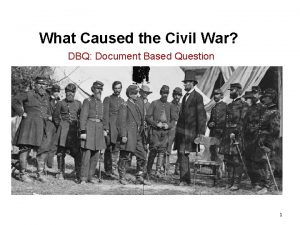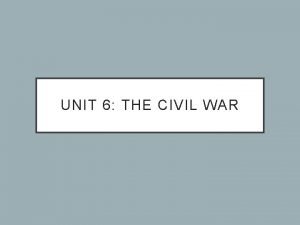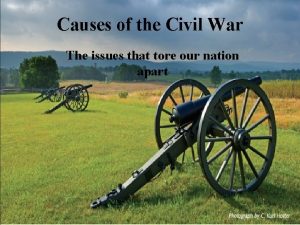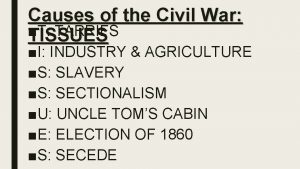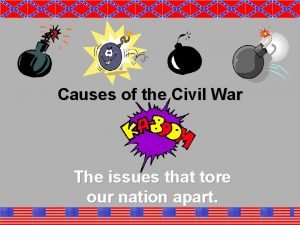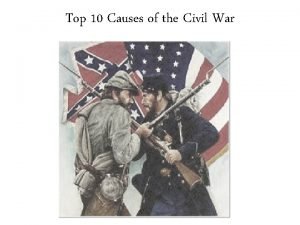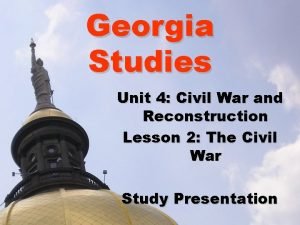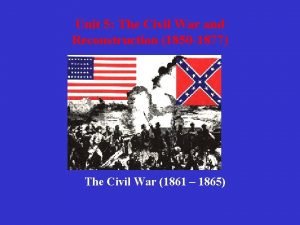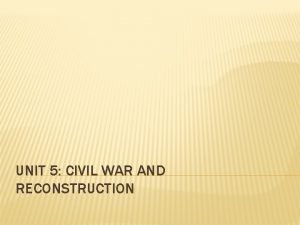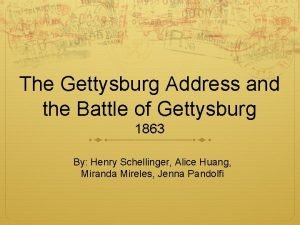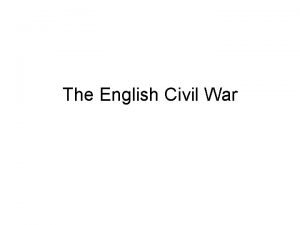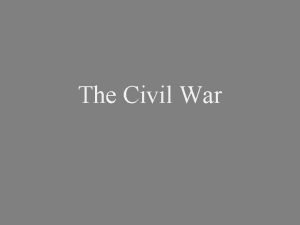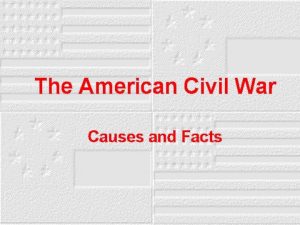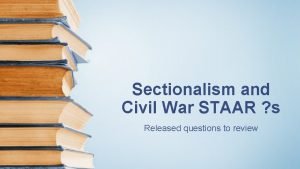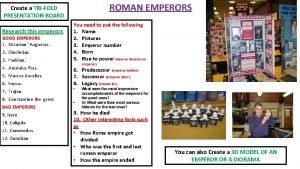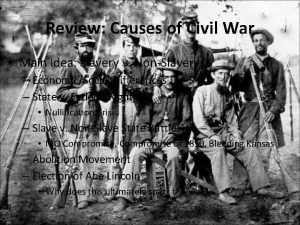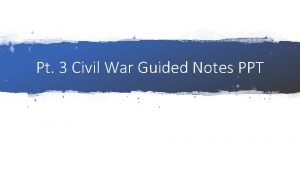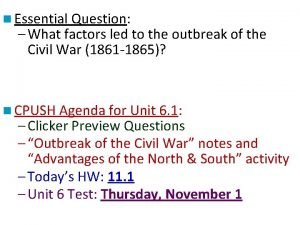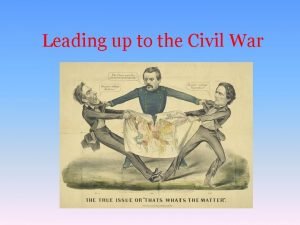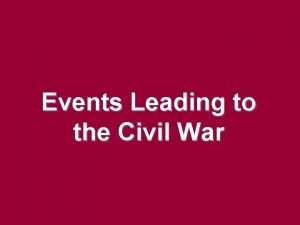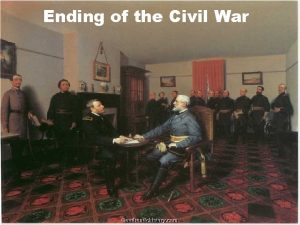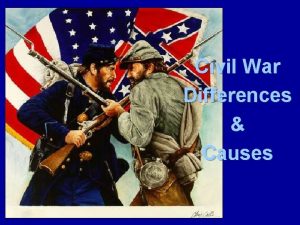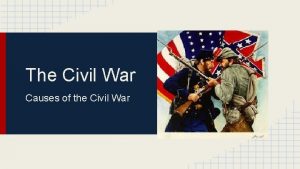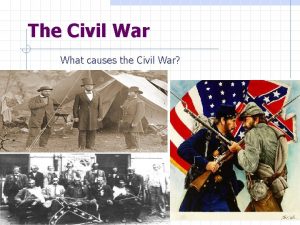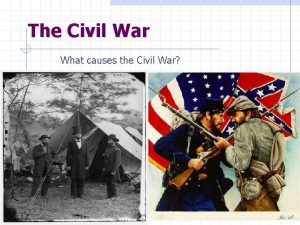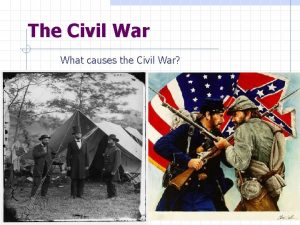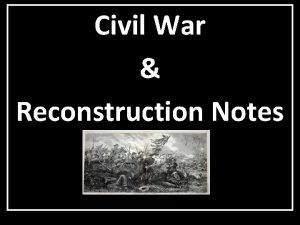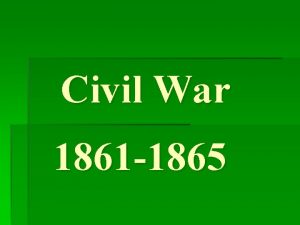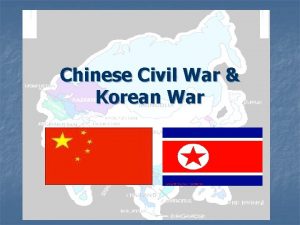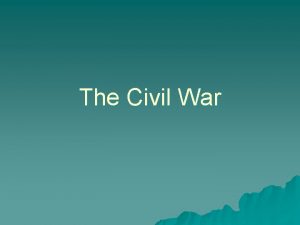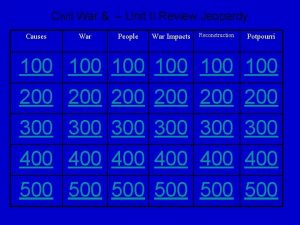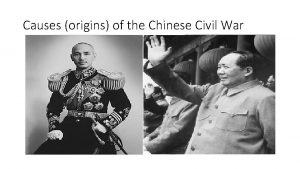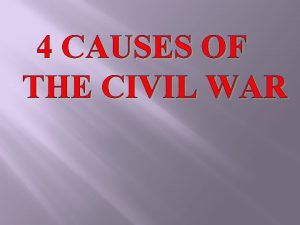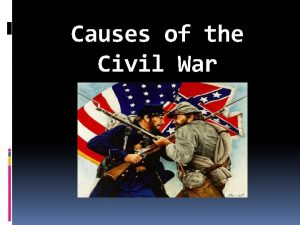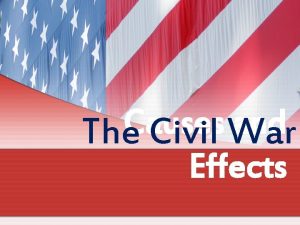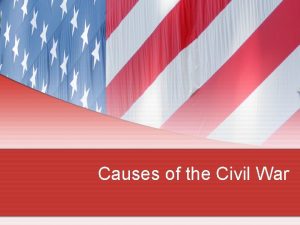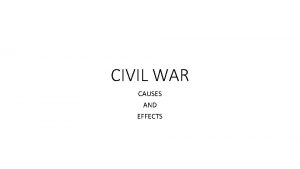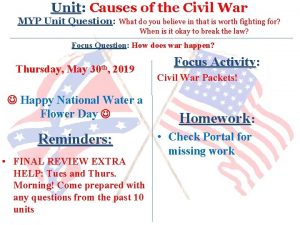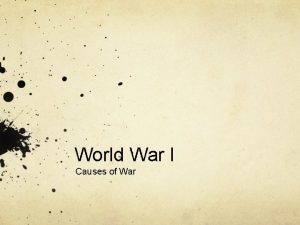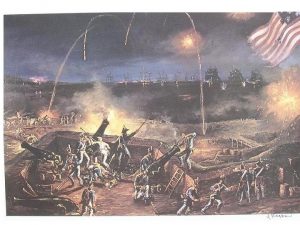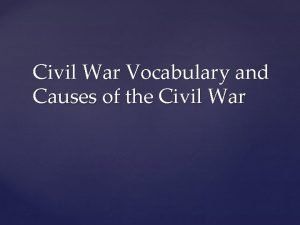UNIT 6 THE CIVIL WAR CAUSES OF THE





























- Slides: 29

UNIT 6: THE CIVIL WAR

CAUSES OF THE CIVIL WAR • 1) Slavery: -Many states in the Union were against letting slavery spread to new territories • 2) States’ Rights/Nullification: -Slave states said federal government should not be allowed to interfere -Southern states saw it -Southern states as their right to own “nullified” or rejected slaves federal laws they deemed Unconstitutional -Abolitionists: People who wanted to end slavery, make it illegal

CAUSES OF THE CIVIL WAR • 3) Compromise of 1850 -Way to keep the peace between proslavery and antislavery states -Fugitive Slave Act included said even if a run away slave made it to a “free state” they would be returned to their “owner” -California would be a “free state” and other states would vote on whether they wanted slavery or not

CAUSES OF THE CIVIL WAR • 4) Georgia Platform -Georgia’s response to the Compromise of 1850 -Said GA would follow the rules and not secede as long as Fed Gov did not try to end slavery -Secede= leave the Union

CAUSES OF THE CIVIL WAR • 5) Dred Scott Case -Supreme Court -1857 Dred Scott went ruled that people to a “free state” with of color could not his owner, he raised a legally sue for legal case challenging they were his own enslavement property and not since he had lived in a people free state for a time -Went to Supreme Court as Dredd Scott v. Sanford

CAUSES OF THE CIVIL WAR • 6) Election of 1860 -Abraham Lincoln, an abolitionist was elected President -Pro-slavery states very unhappy -South Carolina secedes, 4 days after his election -GA secedes January of 1861 -Confederacy formed and declares war against the Union

ELECTORAL MAP OF 1860

COOL HISTORY FACT… • Guess who was pictured at Abraham Lincoln’s inauguration… John Wilkes Booth, his future

MAJOR CAMPAIGNS AND BATTLES OF GEORGIA Union Blockade Battle of Chickamauga Atlanta Campaign March to the Sea Andersonville

GEORGIA DURING THE EARLY YEARS OF THE WAR • After secession, most Georgians hoped to avoid the war and peacefully leave the Union, but the firing on Fort Sumter, SC, on April 12, 1861 made conflict inevitable. • Most Georgians experienced the war on far-off battlefields in Virginia and Tennessee. • For the first three years of the Civil War, Georgia was virtually left untouched.

UNION BLOCKADE: BY SEA • Where: Union Blockade off Georgia’s coast. • What: The Blockade prevented shipping to and from Georgia which led to shortages in everything from military supplies to food. • Effective? It was very effective in blocking much needed supplies for both the military and civilians Important to know: Also known as The Anaconda Plan!

UNION BLOCKADE: BY LAND • Where? : 1862, Big Shanty (later known as Kennesaw) • What? : Union spies took control of a train called The General, made it 99 miles North to Ringgold, Georgia. • How effective? : Not very, they did not manage to damage the railroads in Georgia however someone else will later in the war…. Fun Fact: Disney made a movie about this event called “The Great Locomotive Chase!”

Inquiry Time, Quick Think! Why would the Union target Georgia’s Railroads specifically? What made Georgia’s Railroads so special?

WAR COMES TO GEORGIA BATTLE OF CHICKAMAUGA • Where? : Chickamauga is located in Walker County just 10 miles south of the Tennessee/Georgia line. • When? : 1863, lasted two days from September 19 -20. • Why? : The Union wanted capture the city of Chattanooga, which was an important railroad center and eventually capture the most important railroad hub Atlanta

WAR COMES TO GEORGIA BATTLE OF CHICKAMAGUA Result? : It was the largest Union defeat in the “Western” theater of the War AND the largest battle fought in Georgia. It was the SECOND BLOODIEST battle of the Civil War 34, 000 casualties. What do you think is the bloodiest? Answer: Gettysburg bloodiest multiple day battle, Antietam bloodiest SINGLE day battle

COMPARISON OF THE BLOODIEST BATTLES GETTYSBURG CHICKAMAUGA Antietam • 3 Day Battle • 2 Day Battle � 1 Day Battle (12 hrs. ) • Union Win • Confederate Win � Tie- Union claimed • Confederate Forces Engaged- 75, 000 • Confederate Forces Engaged- 66, 326 • Casualties- 51, 112 • Casualties- 34, 624 • Union- 23, 049 • Union- 16, 170 • Confederate- 28, 063 • Confederate- 18, 454 • 17, 037 Per Day • 17, 312 Per Day as victory because Lee retreated. � Confederate Forces Engaged- 55, 000 � Casualties- 37, 400 � Union- 12, 400 � Confederate- 10, 300 � Total 22, 700

MEANWHILE WARS ARE NOT WON BY BATTLES ALONE… IMPORTANT DOCUMENT: EMANCIPATION PROCLAMATION • When? President Abraham Lincoln issued the Emancipation Proclamation on January 1, 1863, BUT DID IT REALLY FREE ALL THE SLAVES? • Notice the wording, “that all persons held as slaves • What? in the REBELLIOUS The proclamation declared states are and "that all persons held as henceforward shall be slaves" within the rebellious free. ” states "are, and henceforward shall be free. " • Who does that not include freedom for?

SHERMAN’S ATLANTA CAMPAIGN • When? : Beginning in the spring of 1864, Sherman set out to capture Atlanta after defeating the Confederate army in Chattanooga Tennessee. • Why? : Due to Atlanta’s role as the major railroad hub of the South, along with its industrial capabilities, the capture of the city would bring the Confederacy to it’s knees. • Effective? : 4 ½ months and several major battles took place between the two armies including the Battle of Kennesaw Mountain. Sherman continued to win battle after battle until he was close enough to bombard Atlanta with cannon fire. On September 2 1864 Sherman won the city of Atlanta, he began his plan to march to Savannah.

SHERMAN’S ATLANTA CAMPAIGN: FACT VS FICTION • Even today it is widely said that Sherman burned Georgia as he marched through however historical accounts debate this and say that the people of Georgia burned their own farms and cities to prevent the Union Army from benefitting from anything they had • What do you think? Who would have more motive to destroy Atlanta?


THE CIVIL WAR IN PAULDING COUNTY • Paulding County is well known for its role in the Civil War. In 1864, Union General William T. Sherman planned to take over Dallas to control the traffic on the county roads that led to larger cities such as Atlanta and Kennesaw. • Because of the Union’s attempt to control part of Paulding County, three battles took place at New Hope Church, Dallas, and Pickett’s Mill. The battles delayed Sherman’s attack on Atlanta. • Paulding County’s historic Henderson House served as the Union headquarters.

THE CIVIL WAR IN PAULDING COUNTY QUICK FACTS! BATTLE OF NEW HOPE • May 25 -26 • Union- William T. Sherman and Joseph Hooker • Confederate- Joseph E. Johnston • Casualties • Union- 1, 665 • Confederate- 350 • Confederate Victory Battle of Dallas � May 26 -June 1 � Union- William T. Sherman � Confederate- Joseph E. Johnston � Casualties � Union- 2, 400 � Confederate- 3, 000 � Union Victory BATTLE OF PICKETT’S MILL • May 27 • Union- Oliver O. Howard • Confederate- Patrick Cleburne • Casualties • Union- 1, 600 • Confederate- 500 • Confederate Victory

GENERAL SHERMAN’S MARCH TO SEA • When? : November 15, 1864, and ended on December 21, 1864, with Sherman’s capture of Savannah. • Why? : Sherman wanted to punish the South for beginning the war and try to cripple the Confederate army so the war would end quicker. • How effective? : Sherman’s army created a path of destruction that was 300 miles long and 60 miles wide. In the end, Savannah surrendered to Sherman without a fight on December 22, 1864. Sherman wrote to Abraham Lincoln that Savannah was his Christmas present.

GENERAL SHERMAN’S MARCH TO SEA ”ORIGIN OF SHERMAN’S NECKTIES” • As Sherman marched through Georgia he would order his men to tear up rairoad tracks and twist them into impossible to untangle knots that became known as ”Sherman’s Neckties” • Why do you think he did this?

ANDERSONVILLE PRISON CAMP Where? Macon, Georgia When? Opened in 1864 What? The most notorious prison camp of the Civil War, Confederates held captured Union soldiers in inhumane conditions including over crowding, famine, heat, and unsanitary conditions which led to widespread disease. Originally built to hold only 10, 000 prisoners but would hold 34, 000 at its most crowded.

MAKING HISTORIC CONNECTIONS: WHAT OTHER EVENTS IN HISTORY DO THESE PICTURES FROM ANDERSONVILLE REMIND YOU OF?

LEE SURRENDERS • Lee surrendered his Army of Northern Virginia on April 9, 1865, at the Mc. Lean House in the village of Appomattox Court House. In an untraditional gesture and as a sign of Grant's respect and anticipation of peacefully restoring Confederate states to the Union, Lee was permitted to keep his sword and his horse, Traveller.

LINCOLN’S ASSASSINATION • On April 14, 1865, President Lincoln was shot by John Wilkes Booth, a Southern sympathizer. Lincoln died early the next morning, and Andrew Johnson became president.

THE CIVIL WAR ENDS • Confederate forces across the South surrendered as news of Lee's surrender reached them. • President Johnson officially declared an end to the war on May 9, 1865. • Fighting continued in other places. It wasn't until General Watie surrendered on June 23, 1865 when the last major fighting occurred.
 What caused the civil war dbq
What caused the civil war dbq Sherman neckties
Sherman neckties Causes of the civil war jeopardy
Causes of the civil war jeopardy What were the 4 main causes of the civil war
What were the 4 main causes of the civil war Tissues causes of civil war
Tissues causes of civil war What are the 3 main causes of the civil war
What are the 3 main causes of the civil war Causes of the civil war
Causes of the civil war Cause of english civil war
Cause of english civil war Why was the civil war considered the first modern war
Why was the civil war considered the first modern war Chapter 16 lesson 2 challenges to slavery
Chapter 16 lesson 2 challenges to slavery Unit 4: civil war and reconstruction
Unit 4: civil war and reconstruction Unit 5 civil war and reconstruction
Unit 5 civil war and reconstruction Unit 5 civil war and reconstruction
Unit 5 civil war and reconstruction Civil rights and civil liberties webquest
Civil rights and civil liberties webquest Proximate and ultimate causes of behaviour
Proximate and ultimate causes of behaviour Proximate behaviour in animals
Proximate behaviour in animals Civil war map activity
Civil war map activity What battle was the turning point of the civil war
What battle was the turning point of the civil war English civil war timeline
English civil war timeline What led to civil war
What led to civil war Civil war facts
Civil war facts Civil war staar questions
Civil war staar questions Civil war trifold
Civil war trifold Blockade
Blockade Civil war ppt and guided notes
Civil war ppt and guided notes Civil war advantages and disadvantages chart
Civil war advantages and disadvantages chart What led to the civil war
What led to the civil war Civil war trading cards project
Civil war trading cards project What events led to the civil war
What events led to the civil war Civil war map sherman's march to the sea
Civil war map sherman's march to the sea
